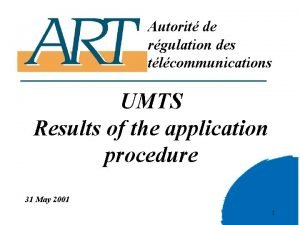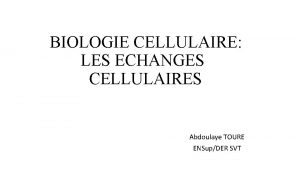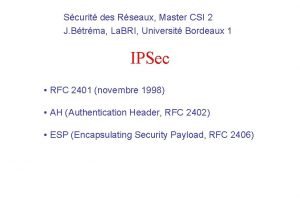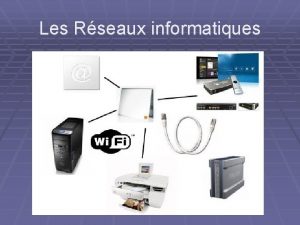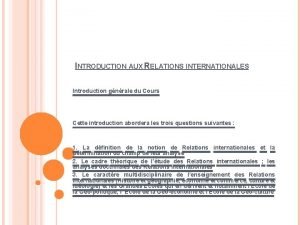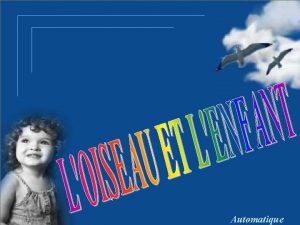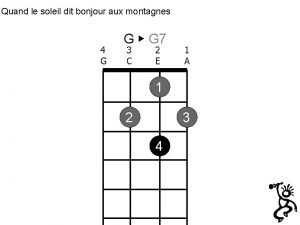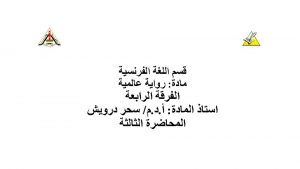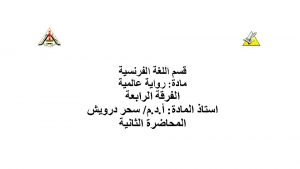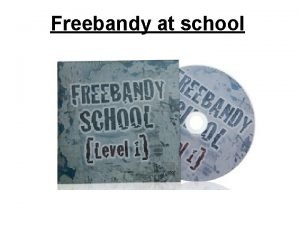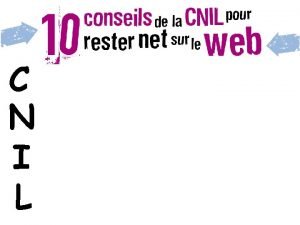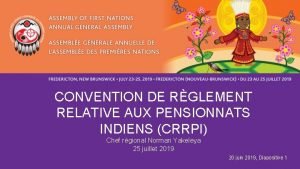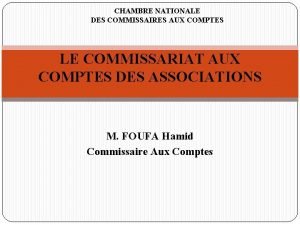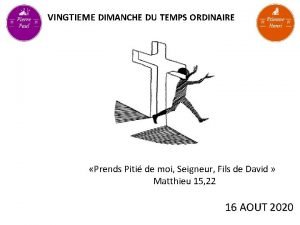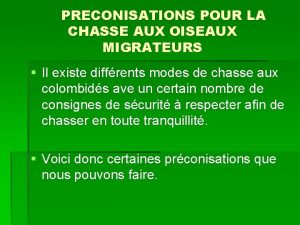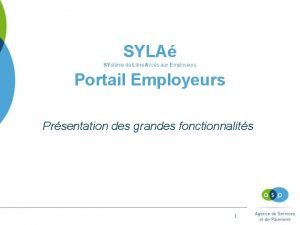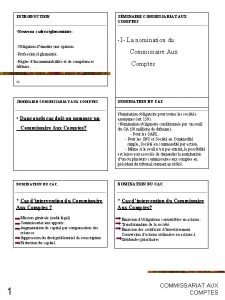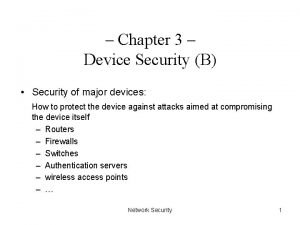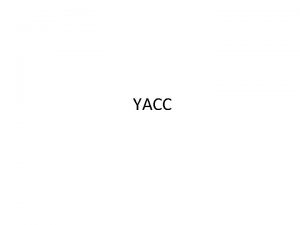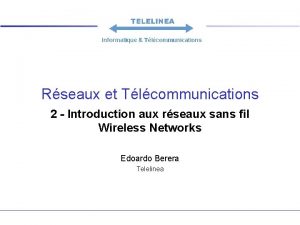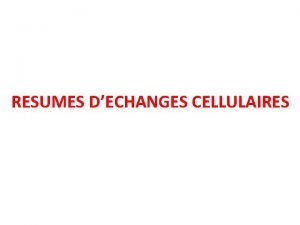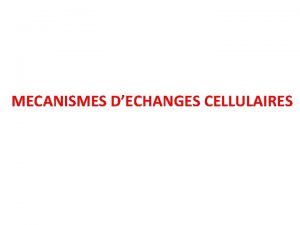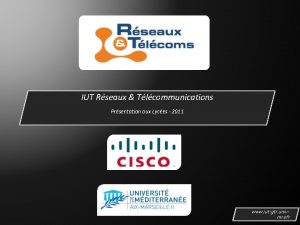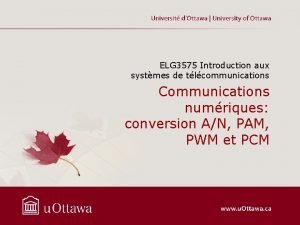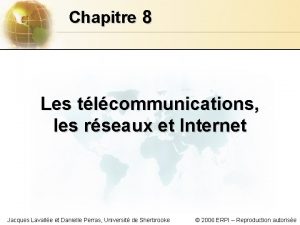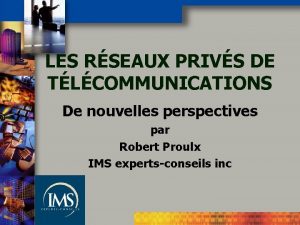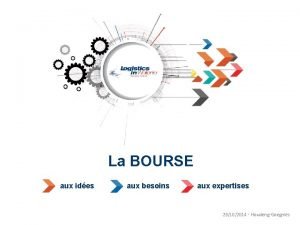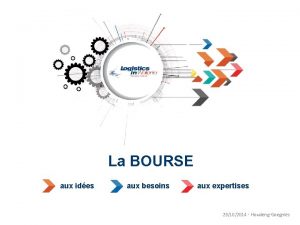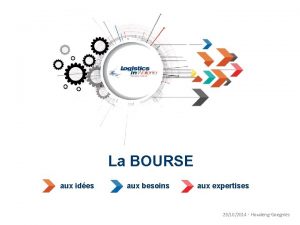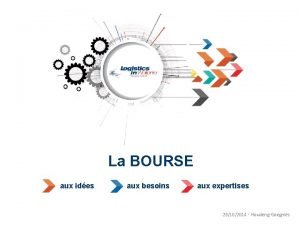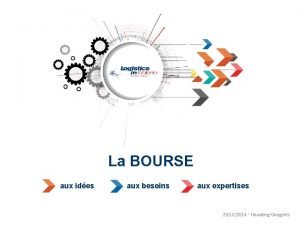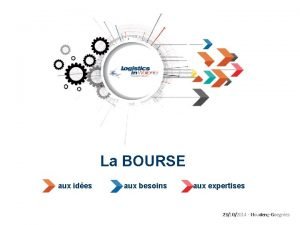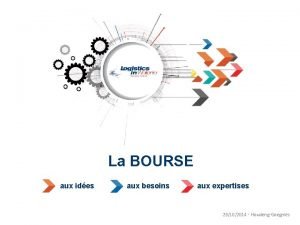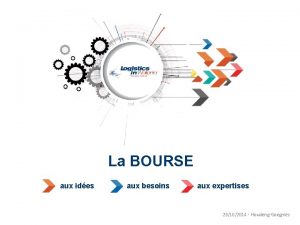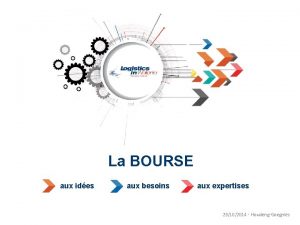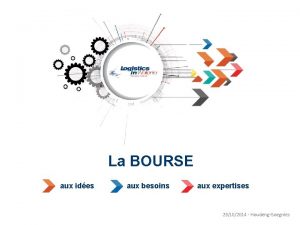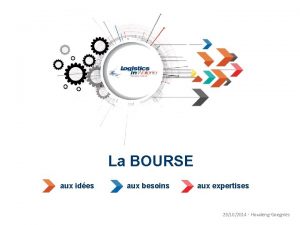Rseaux et Tlcommunications 3 Introduction aux rseaux cellulaires























































- Slides: 55

Réseaux et Télécommunications 3 - Introduction aux réseaux cellulaires Edoardo Berera Telelinea

Plan • • Intelligent Network Digital cellular networks Generations of mobile communications GSM – Global System for Mobile Communication • GSM evolution – GPRS General Packet Radio Service – UMTS Universal Mobile Telecommunications Service • Data services – WAP Wireless Application Protocol – i-mode (internet mode) • • Frequency bands Layered architectures Key technologies Operators

PSTN / Intelligent Network (IN) • Les trois niveaux de l’architecture des réseaux téléphoniques: – transport – signalisation – services intelligents (ordinateurs, bases de données et applications) Source: Modarressi, Bell. South and Mohan, Comverse (IEEE Communications, Oct. 2000, p. 96)

Digital Cellular Networks • Les réseaux cellulaires sont une extension des réseaux de téléphonie fixe – grâce aux services intelligents fournis par les – HLR, Home Location Registers, et les VLR, Visitor Location Registers Source: Oliphant, IFR (IEEE Spectrum, Aug. 1999, p. 21)

Digital Cellular Networks • • PSTN Public Switched Telephone System Services – – • Authentication Center (vérification abonné) Home Location Register (données abonné) Visitor Location Register (localisation abonné) Operations & Maintenance Center (réseau) Commutation – Mobile Switching Center – Gateway Mobile Switching Center (i/f réseau fixe) • Concentrateurs et émetteurs/récepteurs radio – Base Station Controller – Base Transceiver Station • Interfaces – Air Interface (radio), interfaces MSC/BTS (A, Abis) • Téléphone cellulaire – Mobile Station Source: Oliphant, IFR (IEEE Spectrum, Aug. 1999, p. 21)

Multiple frequency allocation • • En 2ème génération (GSM) séparation par fréquence (FDM Frequency Division Multiplexing) En 3ème génération (G 3, UMTS) séparation par codage ( CDM Code Division Multiplexing) Source: Lei and Slimane, Swedish Royal Institute of Technology (IEEE Communications, Oct. 2000, p. 87)

Generations of mobile communications systems • • GSM: Global System for Mobile communications Recherchez les autres acronymes sur Internet Source: Ohmori, MPT Japan, Yamao and Nakajima, NTT (IEEE Communications, Dec. 2000, p. 135)

Mobility and data rates Source: Ohmori, MPT Japan, Yamao and Nakajima, NTT (IEEE Communications, Dec. 2000, p. 134)

Future-generation mobile communications Source: Ohmori, MPT Japan, Yamao and Nakajima, NTT (IEEE Communications, Dec. 2000, p. 138)

Intelligent Transport System (ITS) communications Source: Ohmori, MPT Japan, Yamao and Nakajima, NTT (IEEE Communications, Dec. 2000, p. 139)

High Altitude stratospheric Platform Station (HAPS) Source: Ohmori, MPT Japan, Yamao and Nakajima, NTT (IEEE Communications, Dec. 2000, p. 139)

GSM evolution : toward the third generation (3 G) • • • HSCSD High Speed Circuit Switched Data GPRS General Packet Radio Service EDGE Enhanced Data rate for Global (GSM) Evolution Source: Mohr and Konhaeuser, Siemens (IEEE Communications, Dec. 2000, p. 123)

Electromagnetic Spectrum Source: Microsoft Corp.

Frequency Bands - ISM • Industrial, Scientific, and Medical (ISM) bands • Unlicensed (free) channel bandwidth Short Wave Radio FM Broadcast Infrared wireless LAN AM Broadcast Television Audio Cellular (840 MHz) NPCS (1. 9 GHz) Extremely. Very Low Medium High Very Ultra Super Infrared. Visible Ultra- X-Rays Low High Light violet 902 - 928 MHz 26 MHz 2. 4 - 2. 4835 GHz 83. 5 MHz (IEEE 802. 11) 5 GHz (IEEE 802. 11) Hyper. LAN 2 Source: Chuck Bartel, Carnegie-Mellon University, “Wireless Technologies, Directions in Wireless Networking”, April 2001

New frequency ranges Source: Mohr and Konhaeuser, Siemens (IEEE Communications, Dec. 2000, p. 126)

International frequency allocation • • Différences entre Europe USA et Japon Place très importante allouée par les USA aux transmission sans licence – Quelles sont les conséquences pour les industriels ? Source: Mohr and Konhaeuser, Siemens (IEEE Communications, Dec. 2000, p. 127)

Layered structure of seamless future networks • • Les Hot Spots (terminaux des aéroports, centres de congrès, et un jour peut-être stations-service, etc. ) utilisent Wi-Fi Comparez les hot spots Wi-Fi et les services UMTS (G 3) Source: Mohr and Konhaeuser, Siemens (IEEE Communications, Dec. 2000, p. 130)

Key technologies in wireless access networks Source: Ohmori, MPT Japan, Yamao and Nakajima, NTT (IEEE Communications, Dec. 2000, p. 141)

Cellular system software architecture Source: Ohmori, MPT Japan, Yamao and Nakajima, NTT (IEEE Communications, Dec. 2000, p. 141)

GPRS UMTS • • Universal coverage IMT-2000 UMTS terminals Standards GSM to UMTS transition GPRS Network operators Service providers

Universal coverage Source: UMTS Forum

ITU IMT-2000 • UMTS is one of the major new third generation mobile communications systems being developed within the framework which has been defined by the International Telecommunications Union (ITU) and known as IMT-2000 for International Mobile Telecommunications for the 2000's. . • UMTS will deliver low-cost, high-capacity mobile communications offering data rates up to 2 Mbit/sec with global roaming and other advanced capabilities

UMTS Terminals – – – – Source: UMTS Forum Video Phones PDA Pocket PC Portable PC Wrist watches Music players E-book readers. . .

Market and services • UMTS will play a key role in creating the future mass market for high-quality wireless multimedia communications that will approach 2 billion users worldwide by the year 2010 · UMTS will enable tomorrow’s wireless Information Society, delivering high-value broadband information, commerce and entertainment services to mobile users via fixed, wireless and satellite networks · UMTS will speed convergence between telecommunications, IT, media and content industries to deliver new services and create fresh revenue-generating opportunities

Universal standards ? • Two US standards – CDMA 2000 • Code Division Multiple Access – UWC-136 • Universal Wireless Comms • Rest of the world – WCDMA • Wideband CDMA Source: Oliphant, Tektronix (IEEE Spectrum, Oct. 2000, p. 55)

GSM to UMTS network transition • Step 0: GSM (2 G) – Circuit switched network (Voice and Data) Source: Oliphant, Tektronix (IEEE Spectrum, Oct. 2000, p. 56)

GSM to UMTS network transition • Step 1: GSM (2. 5 G) – + GPRS General Packet Radio Service » Circuit switched network (Voice) » Packet switched network (Data): 92 kb/s max (plus data compression) – + EDGE Enhanced Data rate for GSM/Global Evolution » Circuit switched network (Voice) » Packet switched network (Data): 384 kb/s max (plus data compression)

GPRS • General Packet Radio Service – PCU Packet Control Unit – GPRS Internet Gateway Source: Oliphant, Tektronix (IEEE Spectrum, Oct. 2000, p. 56)

UMTS Phases • Step 2: UMTS (3 G) Phase 1 – Circuit switched network (Voice) – Packet switched network (Data) » 2 Mb/s max (plus data compression) • Step 3: UMTS (3 G) Phase 2 · Packet switched network (Voice and Data) · All IP network (Internet)

UMTS Phase 1 • UTRAN – UMTS Terrestrial Radio Access Network – Urban areas coverage – Dual mode phones • Non IP core network Source: Oliphant, Tektronix (IEEE Spectrum, Oct. 2000, p. 56)

UMTS Phase 2 • IP-based core network • Satellite universal coverage Source: Mohr and Konhaeuser, Siemens (IEEE Communications, Dec. 2000, p. 129)

WAP • • • Wireless Application Protocol Terminals WAP Gateways Wireless Markup Language Services

System Elements • Mobile Terminals – SIM Cards • Cellular Networks – Gateways • Protocols • Languages • Services Nokia 9210 Communicator

Terminals • Cellular Phones – SIM Card Subscriber Identity Module • Authentication • Security • Personalisation – SIM Toolkit • Personal Digital Assistants • Combined PDA/Cellphones

WAP Gateway Source: Neal Leavitt, Leavitt Communications (© IEEE Computer, Dec. 2000, p. 128)

Wireless Application Protocol Stack Source: Riku Mettala, Nokia (© Bluetooth White Paper, Aug. 1999, p. 10)

Wireless Markup Language

i-mode • NTT Do. Co. Mo Japan (1999) – 35 million users • Bouygues Telecom (2002) – using GPRS – charges based on volume of data • Simplified HTML (c. HTML - compact HTML) – page size (including GIF) < 10 kbytes • Simpler than WAP – see Eurotechnology for comparison

Services • Communication services • Information Services • M-Commerce Services – Pull and Push Services – Existing Services – Service Personalisation

Communications and Information Services • E-mail • Directories – Yellow pages – Location dependent • Personalized agenda • Forums and chat • Games • • News Weather Forecasts Traffic Timetables – Train, Airplanes – Movies, Theatres

M-Commerce Services • Phone orders – Physical or electronic delivery and payment – Music, Books (e-songs MP 3 Pro, e-articles) • Reservations and tickets – Accommodation, Transportation and Entertainment • Financial and banking – Accounts management, money orders, stock exchange transactions

M-Commerce Security and Payments • Security – Cell phones tends to be individual – Phone terminal and SIM (Subscriber Identity Module) Card allow for authentication – Encrypted communications • Payments – Individual Accounts managed by Mobile Net Operator – Prepaid Cards are one form of e-cash – Operator may become financial intermediary • especially if it owns content

New role model and service delivery for UMTS • Roles – – Users and subscribers Service providers Access network operators Core transport network operators • Services – – Content providers Value-added service providers Service management Service brokers

New role model and service delivery for UMTS • Roles – Users and subscribers – Access network operators – Core transport network operators – Service providers Source: Mohr and Konhaeuser, Siemens (IEEE Communications, Dec. 2000, p. 124)

Core Transport Network Operator • France Telecom • Cegetel 7 Pro • 9 Telecom • Tele 2 • BT (British Telecom) • FLAG (Fiber Link Around the Globe) • CTR • Completel • Kast Telecom

UMTS Access Network Operators • France - UMTS operators (Licence 4. 95 B euros / 15 years) – Orange – SFR – Bouygues Telecom (candidate) • United Kingdom - UMTS operators (Licence for 20 years) – – – Vodafone (9. 95 B euros) Cellnet (6. 73 B euros) Orange (6. 84 B euros) One 2 One (6. 68 B euros) Hutchison (7. 32 B euros)

UMTS Access Network Operators • Germany - UMTS operators (Licence 8. 4 B euros / 20 years) – Mannesmann – T-Mobil – E-Plus – Viag Interkom – Mobil. Com – Group 3 G • Italy - UMTS operators (Licence 2. 4 B euros / 15 years) – TIM – Omnitel – Wind

UMTS Access Network Operators • Finland - UMTS operators (Free licence for 20 years) – Radiolonja – Sonera – Telia – Suomen Kolne – Gee (Tele 2 Group)

Service providers • Services – Content providers – Value-added service providers – Service management – Service brokers Source: Mohr and Konhaeuser, Siemens (IEEE Communications, Dec. 2000, p. 124)

Service providers • • • Internet Service Providers – Infonie – Wanadoo – AOL – Mageos – . . . • Content Providers – Education • • UNSA (Université en ligne) CERAM MBDS. . . – Entertainment • • Telecom Service Providers – Carrefour Telecom – . . . – Information • • • Value-added Service Providers – Search Engines • Voila • Yahoo • Lycos • Altavista • . . . – Portals • • Vizzavi. . . Canal +. . . – Service Brokers • • CNN Euronews Reuters Bloomberg. . . Travel Financial. . . Service Management Providers – Application Service Providers • • Nav-Link. . .

References • William Johnston, "Europe's future mobile telephony system", IEEE Spectrum, Oct. 1998, pp. 49 -53 • Malcolm W. Oliphant, " The mobile phone meets the Internet", IEEE Spectrum, Aug. 1999, pp. 21 -28 • William Sweet, "Cell phones answer Internet's call", IEEE Spectrum, Aug. 2000, pp. 42 -46 • Malcolm W. Oliphant, "Radio interfaces make the difference in 3 G cellular systems", IEEE Spectrum, Oct. 2000, pp. 53 -58 • Abdi R. Modarressi, Bell. South and Seshadri Mohan, Comverse Network Systems, “Control and Management in Next Generation Networks: Challenges and Opportunities”, IEEE Communications, Oct. 2000, pp. 94 -102 Marcel Mampaey, Alcatel, “TINA for Services and Advanced Signaling and Control in Next-Generation Networks”, IEEE Communications, Oct. 2000, pp. 104 -110 Zhu Lei, Slimane Ben Slimane, Swedish Royal Institute of Technology, “A Multicarrier Allocation (MCA) Scheme for Variable-Rate 3 G Wireless Systems”, (IEEE Communications, Oct. 2000, pp. 86 -91 Shingo Ohmori, MPT Japan, Yasushi Yamao, Nobuo Nakajima, NTT, “The Future Generations of Mobile Communications Based on Broadband Access Technologies”, IEEE Communications, Dec. 2000, pp. 134 -142 Werner Mohr, Walter Konhäuser, Siemens, ”Access Network Evolution Beyond Third Generation Mobile Communications”, IEEE Communications, Dec. 2000, pp. 122 -133 Chuck Bartel, Carnegie-Mellon University, “Wireless Technologies, Directions in Wireless Networking”, April 2001 • • •

References • Malcolm W. Oliphant, "Radio interfaces make the difference in 3 G cellular systems", IEEE Spectrum, Oct. 2000, pp. 53 -58 • Werner Mohr, Walter Konhäuser, Siemens, ”Access Network Evolution Beyond Third Generation Mobile Communications”, IEEE Communications, Dec. 2000, pp. 122 -133 • Christian David, Thierry Gadault et al. , "Le Dossier UMTS", L'Expansion, 18 -31 janvier 2001

Web sites • European Telecommunications Standards Institute (Europe) www. etsi. org • International Telecommunications Union (World) www. itu. org • Universal Mobile Telecommunications Services Forum (World) www. umts-forum. org • 3 G Partnership Project (3 GPP) (World) • 3 GPP 2 (USA) www. 3 gpp. org www. 3 gpp 2. org • Universal Wireless Communications Consortium (USA) www. uwcc. org • Internet Engineering Task Force www. ietf. org • World Wide Web Consortium www. w 3. org

Online Resources • Technology – GSM Association’s Mobile Service Initiative (M-Services) http: //www. gsm. com – GSM World http: //www. gsmworld. com – WAP Forum http: //www. wapforum. org • Developers kits – – – Nokia WAP Toolkit http: //www. forum. nokia. com/developers/wap. htm Ericsson Wap. IDE SDK http: //www. ericsson. com/wap/developer Phone. com UP SDK http: //updev. phone. com

Online Resources (2) • WML Editors – WAPtor http: //www. wapdrive. com – WAPPage http: //www. wapmine. com/downnew. asp – Nokia WML Studio for Dreamweaver http: //www. macromedia. com/exchange (browsers) • WAP Browsers – M 3 Gate http: //www. m 3 gate. com – WAPMan http: //edgematrix. com/products – Your. WAP Wireless Companion http: //www. yourwap. com • i-mode – Bouygues http: //www. imode. fr – Eurotechnology http: //www. eurotechnology. com
 Tlcommunications
Tlcommunications Importance des échanges cellulaires chez les animaux
Importance des échanges cellulaires chez les animaux Rseaux
Rseaux Rseaux sociaux
Rseaux sociaux Rseaux
Rseaux Rseaux
Rseaux Introduction aux relations internationales s1
Introduction aux relations internationales s1 Chere parents
Chere parents Auxlms login
Auxlms login Comme un enfant aux yeux
Comme un enfant aux yeux Alleluia le christ est vivant
Alleluia le christ est vivant Vincent van gogh champ de blé aux corbeaux
Vincent van gogh champ de blé aux corbeaux Quand le soleil dit bonjour aux montagnes
Quand le soleil dit bonjour aux montagnes Lisez le texte puis répondez aux questions
Lisez le texte puis répondez aux questions Lisez le texte mes parents
Lisez le texte mes parents Soyez soumis aux autorités
Soyez soumis aux autorités Exemple pente fatale
Exemple pente fatale Bulgarie aux jeux olympiques d
Bulgarie aux jeux olympiques d Freebandy
Freebandy Surface and deep structure
Surface and deep structure Dans ces murs voués aux merveilles
Dans ces murs voués aux merveilles Ne fait pas aux autres ce que tu n'aimerais
Ne fait pas aux autres ce que tu n'aimerais La dame aux camelias a streetcar named desire
La dame aux camelias a streetcar named desire Ouvre mes yeux seigneur aux merveilles de ton amour paroles
Ouvre mes yeux seigneur aux merveilles de ton amour paroles Fais correspondre les mots aux images
Fais correspondre les mots aux images Rembrandt aux yeux hagards
Rembrandt aux yeux hagards Il sauva daniel de la fosse aux lions
Il sauva daniel de la fosse aux lions Aux armes citoyens
Aux armes citoyens Aspirez aux dons les meilleurs
Aspirez aux dons les meilleurs Est ce que je peux aller aux toilettes s'il vous plait
Est ce que je peux aller aux toilettes s'il vous plait Convention de règlement relative aux pensionnats indiens
Convention de règlement relative aux pensionnats indiens Chambre nationale des commissaires aux comptes
Chambre nationale des commissaires aux comptes Gloire au père
Gloire au père Je regrette l'europe aux anciens parapets signification
Je regrette l'europe aux anciens parapets signification Chasse aux pantes
Chasse aux pantes Heros de la mort aux trousses
Heros de la mort aux trousses Asp syla
Asp syla Pompe aux pommes
Pompe aux pommes Rapport des commissaires aux comptes
Rapport des commissaires aux comptes Reverse telnet cisco aux to console
Reverse telnet cisco aux to console Centre national de formation aux métiers de l'eau
Centre national de formation aux métiers de l'eau Conclusion paragraph format
Conclusion paragraph format National advisory committee 1993
National advisory committee 1993 What is yacc
What is yacc The d.a.r.e. program is an example of ________.
The d.a.r.e. program is an example of ________. Introduction examples for essays
Introduction examples for essays Abstract vs introduction
Abstract vs introduction How long is an introduction
How long is an introduction Formal email introduction
Formal email introduction Bridge paragraph
Bridge paragraph Introduction answer the question
Introduction answer the question How to close an argumentative essay
How to close an argumentative essay Editorial writing examples
Editorial writing examples How to write an advantage and disadvantage essay
How to write an advantage and disadvantage essay Research proposal example
Research proposal example Writing a diary
Writing a diary
